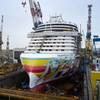According to Xinhua, the latest official blueprint on the China's shipbuilding industry urges the country to crank up efforts over the next five to ten years in order to shoulder its way into the elite club of independent mainstream shipbuilders.
Key development targets enshrined in the National Medium-and Long-Term Plan of the Shipbuilding Industry include: ships to reach international levels of technological sophistication; annual output to hit 17 million deadweight tons (dwt); annual production capacity of medium- and low-speed ship diesel engines to reach 4.5million kw and 1,100 units respectively in order to meet domestic demand; more than 60 percent of ship equipment to be produced locally.
The industrial plan, published by CSTIND and the National Development and Reform Commission, China's industrial watchdog, on September 18, covers policy, targets, technology development, product development, production modernization, foreign cooperation and key projects.
China is the world's third biggest shipbuilder in terms of output, after shipbuilding giants Japan and the Republic of Korea (ROK). In 2005, Japan and ROK accounted for about 70 percent of the global shipbuilding market, while China sailed into third place with 18 percent.
In recent years, China has boosted shipbuilding output by more than 40 percent a year. In the period 2002-2005, China quadrupled capacity from 3.5 million to 12 million dwt.
Growth
The boom in China's shipbuilding industry reflects developments in the marine industry, industry officials said.
China's growing need for foreign energy and mineral resources has spurred domestic shipping companies to expand their fleets. But exports are going well too. More than 70 percent of the ships produced in the country's 861 large shipbuilding enterprises are exported.
China kept up the momentum in the first half of 2006. The 357,946 ships produced were valued at 3.4 billion U.S. dollars, up66.8 percent year on year.
Top destination markets were Germany, Singapore, China's Hong Kong, the Marshall Islands Republic, Malta, Australia, Japan, Panama and the United Kingdom. Each of the nine markets was valued at more than 100 million dollars.
Three types of exported ships each posted sales of more than 500 million dollars: 6,000-and-under TEU container ships (736 million dollars); bulk cargo carriers with a carrying capacity up to 150,000 tons (678 million dollars); and oil tankers up to 100,000 dwt (519 million dollars).
State-owned shipbuilders accounted for 78.1 percent of export sales, Sino-foreign joint ventures 16.8 percent, and privately owned enterprises 5.1 percent.
In the first six months of the year, China's shipbuilders received new orders totaling 16.08 million dwt, up 113 percent over the same period of 2005. Backlog orders amounted to 50.92 million dwt, up 43 percent. Ships built totaled 5.28 million dwt, down 15 percent, said Yu Shichun, deputy director of China Association of National Shipbuilding Industry (CANSI).
China's dwt of ships built, new construction orders and backlog orders constituted respectively 15.3 percent, 27.1 percent and 20.3 percent of world market share, according to statistics with CANSI and the British Clarkson Research Services.
In terms of backlog orders, Dalian Shipbuilding Heavy Industry Co. and Shanghai Waigaoqiao Shipbuilding Company ranked 5th and 10th in the world shipbuilding sector.
Crude oil carriers constituted 50.4 percent of the new orders, and bulk carriers 23.2 percent, CANSI statistics show.
New construction orders mostly involve large ships and batch-based construction.
In the first six months of the year, new orders awarded to China's shipbuilding industry involved 40 ships of 100,000 dwt and upward, and half of them were Very Large Crude Carriers (VLCC) exceeding 200,000 tons loads respectively, according to CANSI statistics.
Challenges
While orders streaming in from shipping companies worldwide are creating fantastic business opportunities, Chinese shipbuilders are also facing very real challenges.
Overall, at least 60 percent of shipboard equipment is imported from overseas, creating a bottleneck for the shipbuilders.
International ship prices have declined since the second half of 2005, with competition becoming more and more intense. Raw material costs, RMB appreciation and exchange rate fluctuations are all key factors for manufacturers to take into consideration.
Besides, the headlong rush to build shipyards may produce an overcapacity situation because China will soon have the capacity for 40 million dwt, or 80% of total global demand.
Although China ranks third in terms of shipbuilding output, its productivity is only about one sixth that of ROK and Japan, making it unable to compete with them on high-value added products such as large liquefied gas and container carriers.
  Prospects
Despite the handicaps, officials are still optimistic about China's chance to become a great world shipbuilder.
The Plan sets forth clear aims for the shipbuilding industry: improve the capacity to design ships and marine equipment, improve the infrastructure for building heavy ships, improve innovation capabilities.
To sharpen the competitive edge of its shipbuilding industry, China hopes to introduce foreign investment through equity-for-technology and market-for-technology deals.
Under the Plan, foreign shipbuilders are allowed to reorganize, acquire or jointly fund shipbuilding enterprises, medium- and low-speed ship diesel engine manufacturing enterprises and crankshaft manufacturing enterprises in China, provided they hold no more than 49 percent of the shares.
Sino-foreign joint ventures must set up a technical center to digest and absorb technologies transferred by foreign investors, said the Plan.
According to the Plan, the reorganization, merger and acquisition of domestic shipbuilding enterprises and medium- and low-speed ship diesel engine manufacturing enterprises by overseas enterprises, overseas-funded enterprises in China, and foreign-controlled joint ventures are treated as newly-created joint ventures.
As for manufacturing the advanced products needed for ships, China will encourage both foreign investors and public investments. It says qualified localities have an opportunity to create ship product manufacturing parks and production bases.
China will encourage seven varieties of shipbuilding project in the future, said Zhang Xiangmu. They include:
-1- Design and manufacturing of high-tech, high-function and special ships, and large ships with 100,000 dwt and above;
-2- Manufacturing of passenger ship, ro-ro passenger ships, passenger-cargo ships and train ferries;
-3- Manufacturing of LPG ships and LNG ships with a handling capacity of 5,000 cubic meters and above;
-4- Manufacturing of container ships with a capacity of 3,000 TEUs and above;
-5- Manufacturing of marine power systems, power plants, and special support machines; design and manufacturing of large deep-sea fishing boats, marine drill vessels, oil rigs, marine floating production storage and offloading (FPSO) structures and other offshore engineering equipment;
-- Manufacturing of ship control and automation products, telecom and navigation equipment, instruments and meters and other marine equipment.
Subscribe for
Maritime Reporter E-News
Maritime Reporter E-News is the maritime industry's largest circulation and most authoritative ENews Service, delivered to your Email five times per week










